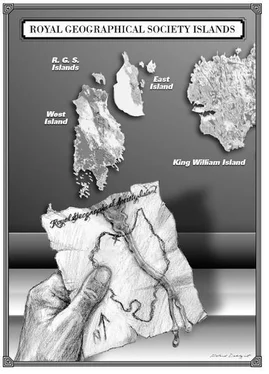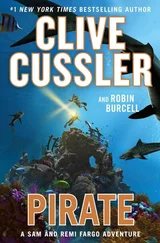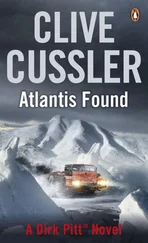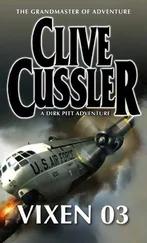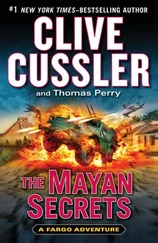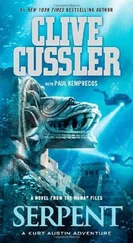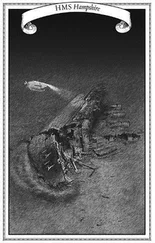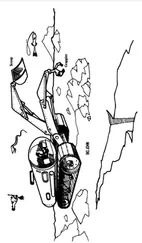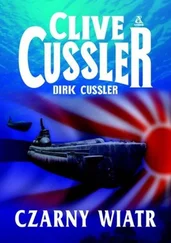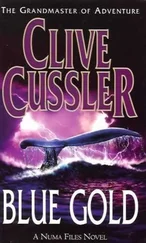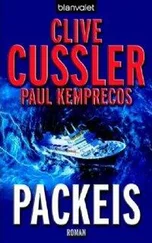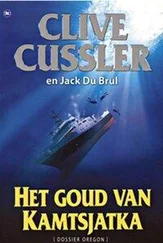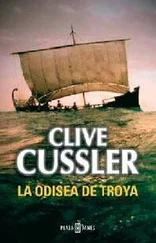“Santa María!” he hissed. “He tore out the record, right in front of me. There was a hand-drawn map of the mine location right there. Now it’s gone.”
The old man slammed the book to the counter while turning an angry eye toward the door. Pitt could see where two pages had been neatly torn from the journal.
“I’d venture to say that your Mr. Booth isn’t who he said he was,” Pitt said.
“I should have suspected something when he didn’t know what a sluice box was,” the man grumbled. “I don’t know why he had to deface our records. He could have just asked for a copy.”
Pitt knew the reason why. Mr. Booth didn’t want anyone else to know the source of the Inuit ruthenium. He slid the journal around and read a partial entry ahead of the missing pages.
October 22, 1917.
Horace Tucker of the Churchill Trading Company consigned following unrefined ore quantities:
5 tons of copper ore
12 tons of lead ore
2 tons of zinc
¼ ton of ruthenium (Adelaide “Black Kobluna”)
Source and assayer comments to follow.
“That was the only Inuit shipment you have received?” Pitt asked.
The old man nodded. “That was it. The missing pages indicated that the mineral had actually been obtained decades earlier. That trading post in Churchill couldn’t find a market for the stuff until Tucker brought a sample in with some minerals from a mine in Manitoba.”
“Any chance the Churchill Trading Company records still exist? ”
“Pretty doubtful. They went out of business back around 1960. I met Tucker a few years later in Winnipeg shortly before he died. I remember him telling me how the old log trading post in Churchill had burned to the ground. I would imagine their trading records were destroyed in the fire.”
“I guess that’s the end of the line, then. I’m sorry about the theft of your data, but thank you for sharing what you know.”
“Hold on a second,” the man replied. He stepped over and opened the thick door to the ancient safe. He rummaged around a wooden bin inside, then turned and tossed something to Pitt. It was a tiny smooth stone, silvery white in color.
“Black Kobluna?” he asked.
“A sample on the house, so that you know what we’ve been talking about.”
Pitt reached across the counter and shook hands with the geologist, thanking him for his time.
“One more thing,” the old man said, as Pitt strolled toward the door. “You run into that Booth fellow, you be sure and tell him I’m coming after him with a pickax if I ever see him again.”
The afternoon had turned colder under the cast of an approaching front, and Pitt waited anxiously for the car heater to warm up as he exited the Co-op’s parking lot. Grabbing a quick lunch at a café in Blind River, he drove back through the winding mountain road toward the airport, contemplating the Inuit ruthenium tale. The ore had to have come from the Arctic, presumably near the Inuit camp at Adelaide. How had the Inuit, with primitive technology, mined the ruthenium? Were there still significant reserves in place? And who was John Booth and why was he interested in the Inuit ore?
The questions brought no answers as he wound through the scenic hills, braking as he pulled up behind a slower-moving RV. Reaching a straight stretch in the road, the RV driver pulled to the shoulder and waved for Pitt to pass. Pitt stomped on the accelerator and sped past the motor home, which he noted had a Colorado license plate.
The road snaked sharply ahead of him, the two lanes carving into the edge of a rocky mountainside that tumbled down to a river below. Twisting through a tight bend, Pitt could see the roadway a mile ahead, where the highway nearly doubled back on a parallel facing. He caught a glimpse of a white sedan parked in a turnout. It was the same vehicle that John Booth had climbed into at the Co-op. Pitt lost sight of the car as the roadway bent and twisted once more.
Rounding through a tight S curve, the road straightened again for a short stretch. To Pitt’s left, the hillside plunged in a steep drop-off, falling several hundred feet to the river below. As his rental car gained speed on the straightaway, Pitt heard a faint pop, like the burst of a distant Fourth of July firework. He glanced ahead but noticed nothing, as a deep rumble followed the initial noise. A movement caught his eye, and he looked up to see a house-sized boulder sliding down the mountainside above him. The huge rock was falling in a perfect trajectory to intersect with Pitt’s car two hundred feet down the road.
Pitt instantly stomped on the brakes, mashing the pedal to the floorboard. The tires chirped and shimmied in protest, but the car’s antilock braking system kept the vehicle from skidding uncontrollably. In the brief seconds Pitt waited for the car to stop, he observed that a full landslide was now under way. In addition to the huge rock, a whole wall of rocks and gravel was chasing the boulder down the mountainside. With seemingly half of the mountain barreling toward him, he knew he would have only one chance to escape.
His quick braking slowed the car just enough to prevent him from being flattened by the first mammoth boulder. The huge rock hit the asphalt just twenty feet in front of him, splintering into several smaller sections. Most of the rock pieces continued their downhill slide, smashing through the guardrail and tumbling down the steep precipice toward the river. A few large chunks died on the road, soon to be buried by the impeding landslide that followed.
Pitt’s car skidded into one of the chunks, a flattened slab of granite that instantly stopped his momentum. Though it mashed the bumper and grille, the car’s mechanics were undamaged. Inside, Pitt felt only a strong jolt, but it was enough to inflate the air bag, which ballooned in front of his chest as the vehicle bounced backward. Pitt’s quick senses had beaten the air bag, though. He had already jammed the automatic transmission in to reverse and stomped on the accelerator at the moment of impact.
The rear tires smoked as they spun wildly before gripping the pavement and propelling the car backward. Pitt gripped the steering wheel and held it steady as the car tried to fishtail from the sudden rearward torque before settling on a stable line. The transmission screamed beneath Pitt’s feet as the low-ratio reverse gear fought to maintain revolutions with the floored engine. Pitt glanced up the hill to see the sliding mass of rocks and gravel already descending upon him. The landslide had spread across a wide line, extending well to his rear. He quickly realized there was no way he could outrun it.
Like a slate-colored tidal wave, the sliding wall of rock cascaded onto the roadway, spilling first a few yards in front of him. For an instant, it appeared as if the speeding car might slip past the deluge, but then a separate cluster of boulders broke free and crashed to the road behind him. Pitt could do nothing but hold on as the car barreled into the moving layer of rocks with a screeching peal of twisted metal.
The car scraped over a large boulder, snapping off the rear axle and sending one of the drive wheels careening down the hill. Pitt was thrown back into his seat as a secondary wall of falling rocks smashed into the passenger side, lifting the car up and over onto its roof. Pitt was flung to his left, his head striking a side air bag as it inflated. Seconds later, he was jarred again to the side again, his head banging through the deflating air bag until striking the driver’s-side window. A great battering roar filled his ears as the car was pummeled across the road, slamming hard to a sudden stop. Inside, Pitt teetered on the brink of consciousness as the sound of rushing gravel surrounded him. His vision went blurry as he was buffeted in his seat, he vaguely felt a warm wetness on his face, and then all feeling vanished as he dropped into a silent void of blackness.
Читать дальше
